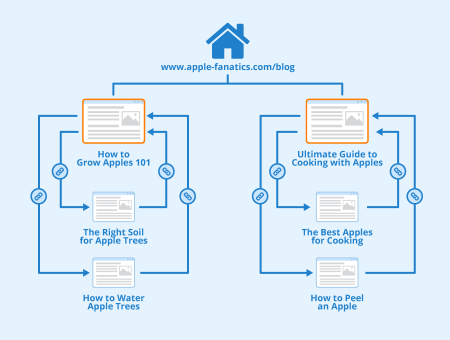What is cornerstone content?
Cornerstone content, also called pillar content or flagship content, refers to the most important overarching pages on a website. Cornerstone content generally covers a broad topic and goes into great detail. Although commonly used to refer to blog posts or webpages, cornerstone content can also be in video or audio form. This form of content generally covers either a company’s products and services (on a page), a broader topic (in a blog post) or an overview of resources (on a page or blog post).
Cornerstone content is often used to link to content on more specific topics mentioned within it, which in turn often link back to the cornerstone piece. This forms topic clusters, which are groups of pages on specific parts of the same broad topic.
Why is cornerstone content used?

Cornerstone content is almost always the most important content on a website. By creating topic clusters around cornerstone content, webmasters show both users and search engines that the content is important, resulting in more visibility and traffic to it.
Cornerstone content helps to create an effective website architecture by structuring a website into separate topics. This helps people navigate from one page to another and makes it easier for them to find the information they’re looking for. Since search engines crawl websites by clicking on links and many search engines have started leveraging artificial intelligence to help them understand what the content on pages means, many SEOs believe that structuring your website using topic clusters can help search engines better understand what pages are about.
Important aspects of cornerstone content
Although cornerstone content is broadly defined as all content that plays an important role on your site, there are a few things you’ll find in most cornerstone content pieces.
Broad long-form content
Most cornerstone content is long-form and contains a lot of information on a broader topic.
Links to other pieces of content
Cornerstone content will often link to other pages on a site, including other blog posts, service/product pages, or other important pages.
A prominent place on the site
Cornerstone content always gets a prominent place on a site, whether that’s on the homepage of the entire site, the homepage of the blog, in the main menu of a site, or another prominent position.
Many inbound internal links
Since cornerstone content is important, it’s often internally linked to from many other pages on the site.
Examples of cornerstone content
- A long-form blog post on the basics of SEO
- A page listing the services a company offers with links to the service-specific pages
- A video introducing a company and what they do
Relevance to SEO
Creating cornerstone content has various SEO and marketing benefits, the main one being an improved user experience. Cornerstone content provides you with information on a broad topic with links to sub-topic pages. This makes it easy for users to find what they’re looking for and improves user signals on your site.
The internal linking that cornerstone content stimulates also provides SEO benefits. Internal links are an important part of SEO and can indicate which pages are most important on a site and transfer what many SEOs call link juice. This also helps prevent orphan pages from being created, since the creation of topic clusters ensures all pages link to various others on the same topic or related topics.
One other advantage that comes with improved internal linking, is that it can be easier to rank cornerstone content. This leads many website owners to target higher-competition keywords with more search traffic.
Related links
- https://copyblogger.com/how-to-create-cornerstone-content-that-google-loves/
- https://www.searchenginejournal.com/make-content-cornerstone-inbound-marketing-strategy/143203/
Similar articles
